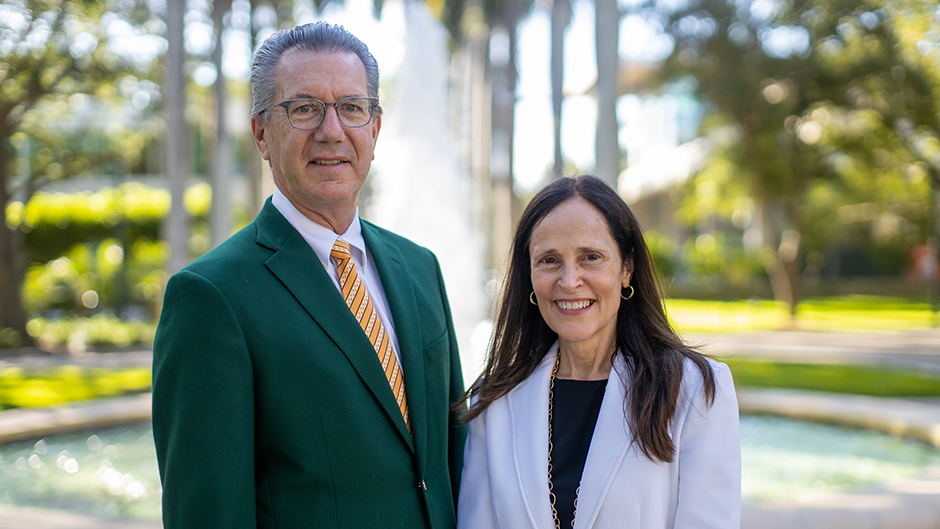Wanted: Well-rounded investment executive; great leadership, mentorship, and matchmaking skills required; penchant for orange and green a plus; poker face a must.
Norma Kenyon, the University of Miami’s vice provost for innovation and the Miller School of Medicine’s chief innovation officer, is looking for the right managing director to run the ’Cane Angel Network (CAN), a venture the University of Miami is launching from the Office of the Provost to give “angel investors” connected to the U the opportunity to invest in promising research, inventions, and ideas emerging from the University family.
“It is essentially a startup to help startups, but it’s all about the U,’’ said Kenyon, who hatched the idea while searching for ways to support early-stage innovations emanating from the University and help bring them to the marketplace. “To qualify as an angel investor or to submit your company for investment you have to be part of the UM community—as an alumnus, faculty or staff, a student, or a direct family member of the above.”
The initiative was launched with $250,000 in founding support from the John S. and James L. Knight Foundation, as part of a $1 million package of investments centered on supporting Miami’s growing innovation community.
"We know that the most successful startup communities are those where founders, investors, and talent are strongly connected,” said Raul Moas, the Knight Foundation’s director for Miami. “UM’s ’Cane Angel Network aligns with this model.”
A blossoming initiative of the Roadmap to Our New Century, the network also aligns closely with the University’s aspiration to be a hub for hemispheric innovation. But it’s as much an ingenious matchmaking, alumni engagement, and educational tool as it is an opportunity for startups to obtain funding.
That’s because the managing director, who won’t have to wear orange and green but will be employed by the University, will identify and engage qualified angel investors, each of whom will pay an annual $2,500 fee to join the network. The director also will oversee up to 10 medical residents and graduate students in business, law, and engineering who will review investment proposals from UM-affiliated company executives or founders.
“The team will do initial triage: Do they have financials? Do they have a plan? Do they have professional management?” said Kenyon, who drew her inspiration from her undergraduate alma mater, Duke University, where student positions at the Duke Angel Network are highly coveted.
“If the company makes it past triage,” she said, “then the manager and his or her team will do a deep due diligence and if the company passes that, their proposal will be posted on the network and the angels can look at the deal and make their own decision.”
Provost Jeffrey Duerk, the University’s executive vice president for academic affairs who holds some 40 patents and spent much of his career fast-tracking innovations to real-world applications, said the due diligence performed by staff will be essential to the angel investors’ decision-making.
“It will also help startup founders understand if they have an invention or an innovation,” Duerk said. “I have always said, ‘An invention is something you make and an innovation is something people will buy.”’
One thing the network manager and staff will not and cannot do is offer an opinion on the wisdom or potential of any proposal.
“In fact, whoever we hire has to have a great poker face because if someone comes up and, with a wink wink, asks, ‘Would you invest in this one?’ they cannot give a hint about that they really think,” Kenyon said. “For regulatory reasons, it’s got to be up to the angels to make the decision.”
Kenyon anticipates that 10 percent of the entrepreneurs who seek investors through the network will pass triage. But that doesn’t mean she sees any shortage of investment opportunities. As the pioneering type 1 diabetes researcher noted, when she assumed her innovation post seven years ago, the University had only a handful of faculty-based startup companies, and was licensing very few of their innovations or ideas.
Today, the University boasts more than 80 faculty-founded startups, and is licensing about 30 faculty inventions a year. Ranging from software to device to therapeutic endeavors, most of the faculty startups, which receive licensing and business development support from the Office of Technology Transfer and the Wallace H. Coulter Center for Translational Research, are biomedically oriented.
The University’s Launch Pad, which historically has supported student and alumni entrepreneurs, has launched over 500 companies in the past 10 years, many which are tech or service oriented.
Kenyon notes that biomedical startups don’t generally attract angel investors because, unlike tech and software platforms, they take longer to turn a profit. But she hopes that, over time, CAN “will get more and more medical alumni to join the network and invest in our early-stage biomedical innovations.”
While CAN itself is not designed to turn a profit for the University, Kenyon is also building a donor-supported co-innovation fund, which will use philanthropic dollars to invest in proposals that reach a set threshold for investors and dollars. If any of those co-invested technologies make money, the University’s share would be plowed back into the evergreen fund to co-invest in other ideas.
“That way, the U is actually investing in our entrepreneurs, generating excitement about the U, and continuing to strengthen our innovation ecosystem,” she said.

